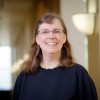This article is more than 5 years old.
This year’s Music Library Association conference was held in Atlanta. It was a very productive meeting for me: I got a lot of continuing education in RDA, the new cataloging standard; and an opportunity to renew contacts in the area of ethnomusicology (music area studies), having learned just before leaving for MLA that our Music Department plans to add an ethnomusicologist to their faculty.
RDA
The impact of RDA, one year after its adoption by the Library of Congress, was apparent in the number of sessions devoted to it during the general conference, not just the catalogers’ sessions sponsored by the Music OCLC Users Group. I learned about revisions made to the music rules in the RDA manual, in MLA’s “Best Practices” document, and in the various music thesauri we use. (So if you see a “Do Not Disturb” sign on my door, you’ll know I have a lot of re-reading to do, all over again!). One sign of the music library community’s clout: MLA’s Best Practices will be incorporated into the official RDA manual, with links integrated into the text alongside LC’s policy statements. In a session on RDA’s impact on public services, I was gratified to find that almost all the talking points presented by the speakers had been covered in my own presentation to our liaisons back in September.
PRESERVATION AND COPYRIGHT
LC gave a report on its National Recordings Preservation Plan (NRPP), which began in February 2013. The group has developed 31 recommendations, which will be presented at hearings scheduled for this year by the US Office of Copyright, covering the entire copyright code, including section 108, orphan works, and pre-1972 sound recordings (the ones not covered by federal law, leaving librarians to navigate a maze of state laws). Also to be presented: a proposed “digital right of first sale,” enabling libraries and archives to perform their roles of providing access and preservation for born-digital works whose licensing currently prohibits us doing so. In the meantime, best-practices documents have been developed for orphan works (by UC Berkeley) and fair use for sound recordings (by the NRPP).
ONLINE LICENSING ISSUES
Perennial, and always interesting, sessions are held at MLA on the ongoing problem of musical works and recordings that are issued only online, with licensing that prohibit libraries and archives from acquiring them. An MLA grant proposal aims to develop alternative licensing language that we can use with recording labels, musicians, etc., allowing us to burn a CD of digital-only files. A lively brainstorming session produced additional potential solutions: an internet radio license, which would stream a label’s catalog to students, at the same time generating revenue for the label; placing links to labels in our catalogs, similar to the Google links that many OPACS feature for books, offering a purchase option; raising awareness among musicians, many of whom are unaware of the threat to their legacies, by speaking at music festivals, and asking the musicians themselves to raise public awareness, perhaps even by writing songs on the topic; capturing websites that aggregate music of specific genres, etc., in the Internet Archive or ArchiveIt; collaborating with JSTOR, PORTICO, and similar projects to expand their archiving activities to media.
DIGITAL HUMANITIES
This hot topic has begun to make its impact on the music library community, and MLA has established a new round table devoted to it. In a panel session, music librarians described the various ways they are providing support for, and collaborating with, their institutions’ DH centers. Many libraries are offering their liaisons workshops and other training opportunities to acquire the technical skills needed to engage with DH initiatives.
OTHER TECHNOLOGICAL PROJECTS
In a panel session on new technologies, we heard from a colleague at the University of Music and Drama in Leipzig, Germany, who led a project to add facets in their VuFind-based discovery layer for different types of music scores (study scores, performance scores, parts, etc.); a colleague at Haverford who used MEI, an XML encoding scheme designed for musical notation, to develop a GUI interface (which they named MerMEId) to produce a digital edition of a 16th-century French songbook, also reconstructing lost parts (we’ve been hearing about MEI for some years — nice to see a concrete example of its application); an app for the Ipad, developed by Touch Press, that offers study aids for selected musical works (such as Beethoven’s 9th symphony) allowing you to compare multiple recordings while following along with a modern score or the original manuscript (which automatically scrolls with the audio), watch a visualization tool that shows who’s playing when in the orchestra, and read textual commentary, some in real time with the audio; a consortium’s use of Amazon’s cloud service to host an instance of Avalon, an audio/video streaming product developed by Indiana U, to support music courses at their respective schools; and ProMusicDB, a project that aims to build an equivalent to IMDB for pop music.

4 Comments on ‘Leslie at MLA 2014’
The technology projects are fascinating, I’m in the process of downloading the Beethoven’s 9th app to check it out!
MLA is at the forefront of many issues. Thanks for bringing all this info back, Leslie.
And Beethoven’s 9th is my all-time fave music, so I am right there with Susan.
Leslie, the more I learn about RDA and the enormity of it all, the happier I am we have you leading that charge! Thanks!
The technological projects sound uh-MAZ-ing! We recently digitized Alexander’s Feast and have been dreaming about some of those possibilities for connecting performances to the score, visualizing parts, and other DH applications!